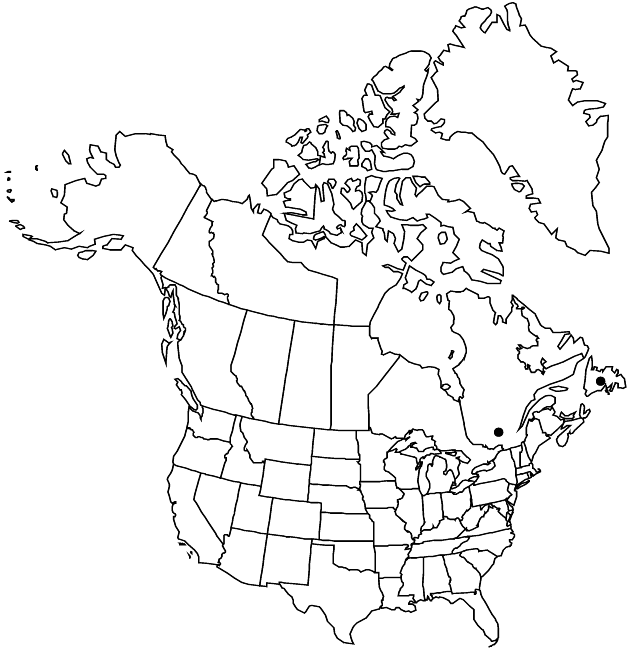Difference between revisions of "Antennaria pulcherrima subsp. eucosma"
Sida 21: 768. 2004.
FNA>Volume Importer |
FNA>Volume Importer |
||
| Line 8: | Line 8: | ||
}} | }} | ||
|common_names=Elegant pussytoes | |common_names=Elegant pussytoes | ||
| − | |basionyms={{Treatment/ID/ | + | |basionyms={{Treatment/ID/Basionym |
|name=Antennaria eucosma | |name=Antennaria eucosma | ||
|authority=Fernald & Wiegand | |authority=Fernald & Wiegand | ||
| + | |publication_title=Rhodora | ||
| + | |publication_place=13: 23. 1911 | ||
}} | }} | ||
|synonyms={{Treatment/ID/Synonym | |synonyms={{Treatment/ID/Synonym | ||
| Line 30: | Line 32: | ||
|elevation=0–300 m | |elevation=0–300 m | ||
|distribution=Nfld. and Labr. (Nfld.);Que. (Anticosti Island). | |distribution=Nfld. and Labr. (Nfld.);Que. (Anticosti Island). | ||
| − | |discussion=<p>Subspecies eucosma is known from limestone barrens in western Newfoundland and Anticosti Island (K. M. Urbanska 1983). It is morphologically similar to <i></i>subsp.<i> pulcherrima</i>; the two are separated mainly by the presence of prominent flags on cauline leaves in <i></i>subsp.<i> pulcherrima</i> and their absence in <i></i>subsp.<i> eucosma</i>.</p> | + | |discussion=<p>Subspecies eucosma is known from limestone barrens in western Newfoundland and Anticosti Island (K. M. Urbanska 1983). It is morphologically similar to <i></i></i>subsp.<i><i> pulcherrima</i>; the two are separated mainly by the presence of prominent flags on cauline leaves in <i></i></i>subsp.<i><i> pulcherrima</i> and their absence in <i></i></i>subsp.<i><i> eucosma</i>.</p> |
|tables= | |tables= | ||
|references= | |references= | ||
| Line 54: | Line 56: | ||
|publication year=2004 | |publication year=2004 | ||
|special status= | |special status= | ||
| − | |source xml=https://jpend@bitbucket.org/aafc-mbb/fna-data-curation.git/src/ | + | |source xml=https://jpend@bitbucket.org/aafc-mbb/fna-data-curation.git/src/f6b125a955440c0872999024f038d74684f65921/coarse_grained_fna_xml/V19-20-21/V19_639.xml |
|tribe=Asteraceae tribe Gnaphalieae | |tribe=Asteraceae tribe Gnaphalieae | ||
|genus=Antennaria | |genus=Antennaria | ||
Revision as of 19:38, 24 September 2019
Plants 8–25 cm. Basal leaves lanceolate to oblanceolate, 50–170 × 5–18 mm, faces silvery sericeous. Cauline leaves 7–30 mm, mostly not flagged (sometimes flagged near heads). Heads 3–15. Involucres: staminate 5.5–7 mm; pistillate 7–10 mm. Phyllaries distally light brown or castaneous. Corollas: staminate 3–4 mm; pistillate 3–4.3 mm. Cypselae 1.2–1.5 mm; pappi: staminate 4–6 mm; pistillate 5–7 mm. 2n = 56.
Phenology: Flowering summer.
Habitat: Limestone barrens, serpentine
Elevation: 0–300 m
Distribution

Nfld. and Labr. (Nfld.), Que. (Anticosti Island).
Discussion
Subspecies eucosma is known from limestone barrens in western Newfoundland and Anticosti Island (K. M. Urbanska 1983). It is morphologically similar to subsp. pulcherrima; the two are separated mainly by the presence of prominent flags on cauline leaves in subsp. pulcherrima and their absence in subsp. eucosma.
Selected References
None.